如何在Excel中找到所有等于给定总和的组合?
发现列表中相加等于特定总和的所有可能数字组合,是许多Excel用户可能会遇到的挑战,无论是用于预算编制、规划还是数据分析目的。
在此示例中,我们有一个数字列表,目标是从该列表中找出哪些组合的总和为480。提供的截图显示有五组可能的组合可以达到此总和,包括像300+120+60、250+120+60+50这样的组合。在本文中,我们将探讨各种方法来确定列表中总计为指定值的特定数字组合。

使用求解器功能查找等于给定总和的单元格组合
深入研究Excel以找到加起来等于特定数字的单元格组合可能看起来令人生畏,但求解器插件使这一过程变得轻而易举。我们将引导您完成设置求解器并找到正确单元格组合的简单步骤,让看似复杂的任务变得简单且可行。
步骤1:启用求解器插件
- 请前往 文件 > 选项,在 Excel选项 对话框中,点击 加载项 从左侧窗格中选择,然后点击 转到 按钮。见截图:
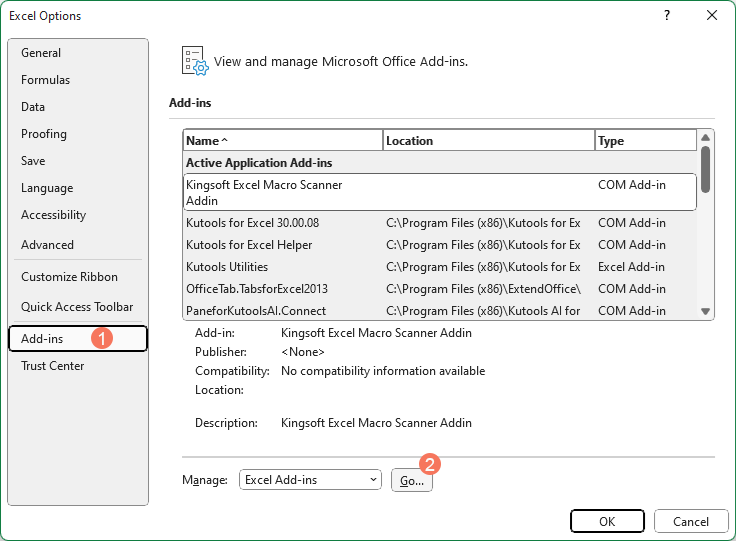
- 然后, 加载项 对话框出现,请勾选 求解器加载项 选项,并点击 确定 以成功安装此加载项。

步骤2:输入公式
激活求解器加载项后,您需要将此公式输入到单元格B11中:
=SUMPRODUCT(B2:B10,A2:A10)
步骤3:配置并运行求解器以获取结果
- 点击 数据 > 求解器 进入 求解器参数 对话框,在对话框中,请执行以下操作:
- (1.) 点击
 按钮以选择单元格 B11 即公式所在的位置,从 设置目标 部分;
按钮以选择单元格 B11 即公式所在的位置,从 设置目标 部分; - (2.) 然后在“至”部分,选择“值为”,并根据需要输入目标值 480;
- (3.) 在 通过更改可变单元格 部分,请点击
 按钮以选择单元格范围 B2:B10 这将标记您的相应数字。
按钮以选择单元格范围 B2:B10 这将标记您的相应数字。 - (4.) 然后,点击添加按钮。

- (1.) 点击
- 然后, 添加约束 对话框显示,点击
 按钮以选择单元格范围 B2:B10,并从下拉列表中选择 二进制 最后,点击 确定 按钮。见截图:
按钮以选择单元格范围 B2:B10,并从下拉列表中选择 二进制 最后,点击 确定 按钮。见截图: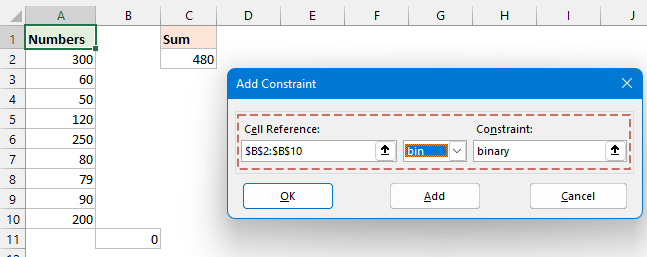
- 在 求解器参数 对话框中,点击 求解 按钮,几分钟后,弹出一个 求解器结果 对话框,您可以看见等于给定总和480的单元格组合在列B中标记为1。在 求解器结果 对话框中,请选择 保留求解器解决方案 选项,并点击 确定 退出对话框。见截图:

使用用户定义函数获取等于给定总和的所有数字组合
为了揭示来自特定集合中的每个可能的数字组合,这些组合共同达到给定值,下面概述的自定义函数是一个有效的工具。
步骤1:打开VBA模块编辑器并复制代码
- 在Excel中按住ALT + F11键,打开Microsoft Visual Basic for Applications窗口。
- 点击 插入 > 模块,并将以下代码粘贴到模块窗口中。
VBA代码:获取等于给定总和的所有数字组合Public Function MakeupANumber(xNumbers As Range, xCount As Long) 'updateby Extendoffice Dim arrNumbers() As Long Dim arrRes() As String Dim ArrTemp() As Long Dim xIndex As Long Dim rg As Range MakeupANumber = "" If xNumbers.CountLarge = 0 Then Exit Function ReDim arrNumbers(xNumbers.CountLarge - 1) xIndex = 0 For Each rg In xNumbers If IsNumeric(rg.Value) Then arrNumbers(xIndex) = CLng(rg.Value) xIndex = xIndex + 1 End If Next rg If xIndex = 0 Then Exit Function ReDim Preserve arrNumbers(0 To xIndex - 1) ReDim arrRes(0) Call Combinations(arrNumbers, xCount, ArrTemp(), arrRes()) ReDim Preserve arrRes(0 To UBound(arrRes) - 1) MakeupANumber = arrRes End Function Private Sub Combinations(Numbers() As Long, Count As Long, ArrTemp() As Long, ByRef arrRes() As String) Dim currentSum As Long, i As Long, j As Long, k As Long, num As Long, indRes As Long Dim remainingNumbers() As Long, newCombination() As Long currentSum = 0 If (Not Not ArrTemp) <> 0 Then For i = LBound(ArrTemp) To UBound(ArrTemp) currentSum = currentSum + ArrTemp(i) Next i End If If currentSum = Count Then indRes = UBound(arrRes) ReDim Preserve arrRes(0 To indRes + 1) arrRes(indRes) = ArrTemp(0) For i = LBound(ArrTemp) + 1 To UBound(ArrTemp) arrRes(indRes) = arrRes(indRes) & "," & ArrTemp(i) Next i End If If currentSum > Count Then Exit Sub If (Not Not Numbers) = 0 Then Exit Sub For i = 0 To UBound(Numbers) Erase remainingNumbers() num = Numbers(i) For j = i + 1 To UBound(Numbers) If (Not Not remainingNumbers) <> 0 Then ReDim Preserve remainingNumbers(0 To UBound(remainingNumbers) + 1) Else ReDim Preserve remainingNumbers(0 To 0) End If remainingNumbers(UBound(remainingNumbers)) = Numbers(j) Next j Erase newCombination() If (Not Not ArrTemp) <> 0 Then For k = 0 To UBound(ArrTemp) If (Not Not newCombination) <> 0 Then ReDim Preserve newCombination(0 To UBound(newCombination) + 1) Else ReDim Preserve newCombination(0 To 0) End If newCombination(UBound(newCombination)) = ArrTemp(k) Next k End If If (Not Not newCombination) <> 0 Then ReDim Preserve newCombination(0 To UBound(newCombination) + 1) Else ReDim Preserve newCombination(0 To 0) End If newCombination(UBound(newCombination)) = num Combinations remainingNumbers, Count, newCombination, arrRes Next i End Sub
步骤2:输入自定义公式以获取结果
粘贴代码后,关闭代码窗口返回工作表。在空白单元格中输入以下公式以输出结果,然后按Enter键获取所有组合。见截图:
=MakeupANumber(A2:A10,B2)
=TRANSPOSE(MakeupANumber(A2:A10,B2))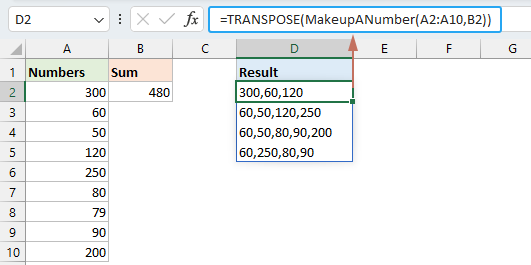
- 此自定义函数仅适用于Excel 365和2021。
- 此方法仅对正数有效;小数值会自动四舍五入到最接近的整数,负数将导致错误。
使用强大功能获取等于给定总和的所有数字组合
鉴于上述功能的局限性,我们推荐一种快速且全面的解决方案:Kutools for Excel的凑数功能,兼容任何版本的Excel。此替代方案可以有效处理正数、小数和负数。使用此功能,您可以快速获取所有等于给定总和的组合。
- 点击 Kutools > 文本 > 凑数,见截图:

- 然后,在 凑数 对话框中,请点击
 按钮以从 数据源中选择您要使用的数字列表,然后在 总和 文本框中输入总数。最后,点击 确定 按钮,见截图:
按钮以从 数据源中选择您要使用的数字列表,然后在 总和 文本框中输入总数。最后,点击 确定 按钮,见截图: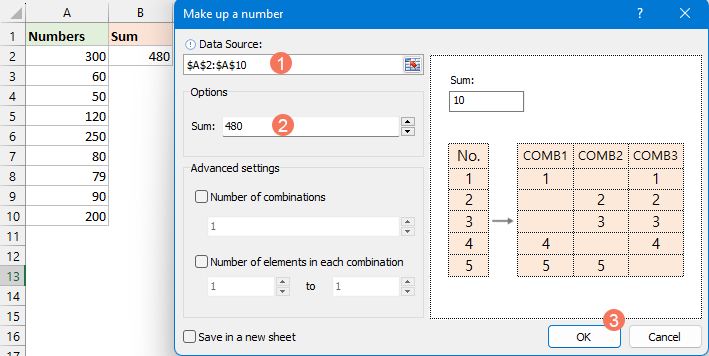
- 然后,会弹出一个提示框提醒您选择一个单元格以放置结果,然后点击 确定,见截图:
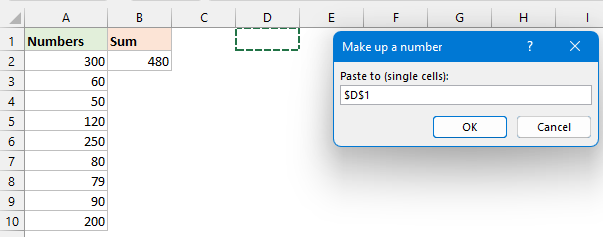
- 现在,所有等于给定数字的组合都已显示如下截图所示:
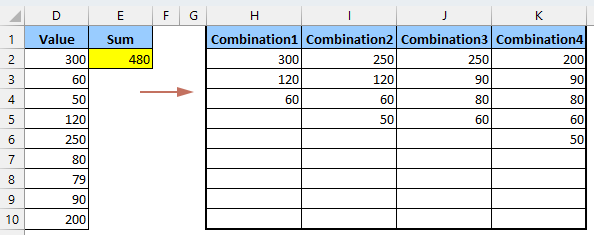
使用VBA代码获取范围内具有总和的所有数字组合
有时,您可能会发现自己处于需要识别所有可能的数字组合的情况下,这些数字的总和落在特定范围内。例如,您可能希望找到每种可能的数字分组,其中总和介于470和480之间。
发现总和落在特定范围内的所有可能数字组合代表了Excel中一个引人入胜且高度实用的挑战。本节将介绍一个VBA代码来解决此任务。
步骤1:打开VBA模块编辑器并复制代码
- 在Excel中按住ALT + F11键,打开Microsoft Visual Basic for Applications窗口。
- 点击 插入 > 模块,并将以下代码粘贴到模块窗口中。
VBA代码:获取总和为特定范围的所有数字组合Sub Getall_combinations() 'Updateby Extendoffice Dim xNumbers As Variant Dim Output As Collection Dim rngSelection As Range Dim OutputCell As Range Dim LowLimit As Long, HiLimit As Long Dim i As Long, j As Long Dim TotalCombinations As Long Dim CombTotal As Double Set Output = New Collection On Error Resume Next Set rngSelection = Application.InputBox("Select the range of numbers:", "Kutools for Excel", Type:=8) If rngSelection Is Nothing Then MsgBox "No range selected. Exiting macro.", vbInformation, "Kutools for Excel" Exit Sub End If On Error GoTo 0 xNumbers = rngSelection.Value LowLimit = Application.InputBox("Select or enter the low limit number:", "Kutools for Excel", Type:=1) HiLimit = Application.InputBox("Select or enter the high limit number:", "Kutools for Excel", Type:=1) On Error Resume Next Set OutputCell = Application.InputBox("Select the first cell for output:", "Kutools for Excel", Type:=8) If OutputCell Is Nothing Then MsgBox "No output cell selected. Exiting macro.", vbInformation, "Kutools for Excel" Exit Sub End If On Error GoTo 0 TotalCombinations = 2 ^ (UBound(xNumbers, 1) * UBound(xNumbers, 2)) For i = 1 To TotalCombinations - 1 Dim tempArr() As Double ReDim tempArr(1 To UBound(xNumbers, 1) * UBound(xNumbers, 2)) CombTotal = 0 Dim k As Long: k = 0 For j = 1 To UBound(xNumbers, 1) If i And (2 ^ (j - 1)) Then k = k + 1 tempArr(k) = xNumbers(j, 1) CombTotal = CombTotal + xNumbers(j, 1) End If Next j If CombTotal >= LowLimit And CombTotal <= HiLimit Then ReDim Preserve tempArr(1 To k) Output.Add tempArr End If Next i Dim rowOffset As Long rowOffset = 0 Dim item As Variant For Each item In Output For j = 1 To UBound(item) OutputCell.Offset(rowOffset, j - 1).Value = item(j) Next j rowOffset = rowOffset + 1 Next item End Sub
步骤2:执行代码
- 粘贴代码后,按 F5 键运行此代码,在第一个弹出的对话框中,选择您要使用的数字范围,并点击 确定。见截图:

- 在第二个提示框中,选择或输入低限数字,并点击 确定。见截图:

- 在第三个提示框中,选择或输入高限数字,并点击 确定。见截图:
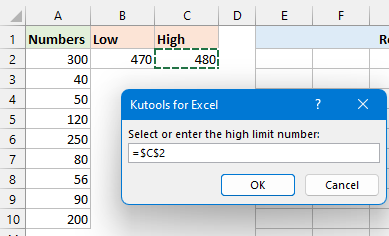
- 在最后一个提示框中,选择一个输出单元格,这是结果开始输出的地方。然后点击 确定。见截图:

结果
现在,每个符合条件的组合将在工作表的连续行中列出,从您选择的输出单元格开始。
Excel提供了几种方法来找到加起来等于某个总和的数字组,每种方法的工作方式不同,因此您可以根据对Excel的熟悉程度以及项目需求选择一种。如果您有兴趣探索更多Excel技巧和窍门,我们的网站提供了数千个教程。感谢您的阅读,我们期待未来为您提供更多有用的信息!
相关文章:
- 列出或生成所有可能的组合
- 假设,我有以下两列数据,现在,我想基于这两列值生成所有可能组合的列表,如左图所示。也许,如果只有几个值,您可以逐一列出所有组合,但如果有多列包含多个值需要列出可能的组合,这里有一些快速技巧可以帮助您在Excel中处理这个问题。
- 列出单列中的所有可能组合
- 如果您想从单列数据返回所有可能的组合以获得如下截图所示的结果,您是否有任何快速方法来处理Excel中的此任务?
- 生成3或多列的所有组合
- 假设,我有3列数据,现在,我想生成或列出这些3列数据中的所有组合作为以下截图所示。您是否有任何好方法可以在Excel中解决此任务?
- 生成所有可能的4位数字组合列表
- 在某些情况下,我们可能需要生成0到9的所有可能的4位数字组合列表,这意味着生成0000、0001、0002…9999的列表。为了在Excel中快速解决此列表任务,我为您介绍了一些技巧。
最佳Office办公效率工具
| 🤖 | Kutools AI 助手:以智能执行为基础,彻底革新数据分析 |代码生成 |自定义公式创建|数据分析与图表生成 |调用Kutools函数…… |
| 热门功能:查找、选中项的背景色或标记重复项 | 删除空行 | 合并列或单元格且不丢失数据 | 四舍五入…… | |
| 高级LOOKUP:多条件VLookup|多值VLookup|多表查找|模糊查找…… | |
| 高级下拉列表:快速创建下拉列表 |依赖下拉列表 | 多选下拉列表…… | |
| 列管理器: 添加指定数量的列 | 移动列 | 切换隐藏列的可见状态 | 比较区域与列…… | |
| 特色功能:网格聚焦 |设计视图 | 增强编辑栏 | 工作簿及工作表管理器 | 资源库(自动文本) | 日期提取 | 合并数据 | 加密/解密单元格 | 按名单发送电子邮件 | 超级筛选 | 特殊筛选(筛选粗体/倾斜/删除线等)…… | |
| 15大工具集:12项 文本工具(添加文本、删除特定字符等)|50+种 图表 类型(甘特图等)|40+实用 公式(基于生日计算年龄等)|19项 插入工具(插入二维码、从路径插入图片等)|12项 转换工具(小写金额转大写、汇率转换等)|7项 合并与分割工具(高级合并行、分割单元格等)| …… |
通过Kutools for Excel提升您的Excel技能,体验前所未有的高效办公。 Kutools for Excel提供300多项高级功能,助您提升效率并节省时间。 点击此处获取您最需要的功能……
Office Tab为Office带来多标签界面,让您的工作更加轻松
- 支持在Word、Excel、PowerPoint中进行多标签编辑与阅读。
- 在同一个窗口的新标签页中打开和创建多个文档,而不是分多个窗口。
- 可提升50%的工作效率,每天为您减少数百次鼠标点击!
所有Kutools加载项,一键安装
Kutools for Office套件包含Excel、Word、Outlook和PowerPoint的插件,以及Office Tab Pro,非常适合跨Office应用团队使用。
- 全能套装——Excel、Word、Outlook和PowerPoint插件+Office Tab Pro
- 单一安装包、单一授权——数分钟即可完成设置(支持MSI)
- 协同更高效——提升Office应用间的整体工作效率
- 30天全功能试用——无需注册,无需信用卡
- 超高性价比——比单独购买更实惠












